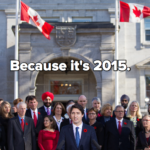By: Taya Nabuurs

image courtesy of mic.com
With the implementation of 50/50 gender parity for which he had social media buzzing with clips of his now-infamous statement, “because it’s 2015,†Justin Trudeau’s efforts to stress the importance of gender equality in Canada and destigmatize the feminist movement are admirable and a breath of fresh air after the previous government’s continual dismissal of women’s issues. However, the fine print in Trudeau’s promises don’t quite add up to policies that are as progressive as he portrays them to be.
Since the 1980’s, the Canadian government has not been able to successfully pass legislation which would implement the publicly-funded childcare programs needed to encourage women’s participation in the workforce. Throwing money at parents does not provide the safe, affordable, organized childcare programs that must exist to allow mothers the freedom and peace of mind to participate to their full potential in society and gain parity in the workplace. Canadians have varying ideas about providing childcare in the country, and the divide between those who support cash handouts for parents versus those who support government investment in public childcare spaces has prevented the government from doing what they need to do.
The Mulroney, Chrétien, and Martin governments all made steps towards public childcare facilities until the Harper government came to power and canceled all federal-provincial agreements, stating that it wanted nothing to do with “institutionalized childcare.† Now, however, for all of his progressive “feminist†rhetoric,  Trudeau’s only real commitment to the future of childcare in Canada lies in his promise to make Harper’s Universal Child Care Benefit “more progressive,†which, in the end, doesn’t provide much hope for the future. Without any recognition of the urgent need for a national childcare program, the Trudeau government is doomed to follow in the footsteps of its predecessor.
Women have historically been seen as the primary child-rearing gender, responsible for the majority of household duties. This notion is reflected in the history of women’s participation in the workforce and even today, studies have shown that women spend an average of two hours more a day on household duties than their male counterparts.
While social norms and expectations can be difficult to overcome, government can make significant improvements to the status of women by implementing policies which allow and encourage them to participate more fully in society. Access to safe and affordable public childcare spaces is one such opportunity through which government can assist mothers in their domestic responsibilities and allow them to participate in the workforce if they so choose, putting them on a more even playing field alongside their male counterparts and ensuring better economic security for women and their children.
Quebec has proven itself to be an excellent example for the rest of the country in establishing greater gender equality in the province with the success of its publicly-funded childcare program . In 1998, Quebec implemented a publicly-funded childcare program that now serves 70% of the province’s preschool-age population. Since the implementation of this program, Quebec has seen a significant increase in the number of women in the workforce and enrolled in postsecondary education, so much so that it now holds the highest rates in the country. Quebec also saw its child poverty rate drop by 50% between 1998 and 2008.
Despite its perception as a very progressive country – especially in terms of women’s rights – Canada was ranked at only number 25 in the UNDP Human Development Report’s Gender Inequality Index in 2015. Women are still making on average $0.70 to every dollar that a man earns per year and despite the fact that women now have higher attainment rates of postsecondary education than men, they are still not participating in the workforce to the same extent as their male counterparts.
This just goes to show that despite surface perceptions on the equality of the sexes in Canada, the numbers and policies don’t always add up to be as progressive as we assume them to be. If Trudeau plans to make any substantial and valuable changes to the level of gender inequality in this country, his efforts must go beyond surface statements and extend into real policy solutions; because it’s 2016.











